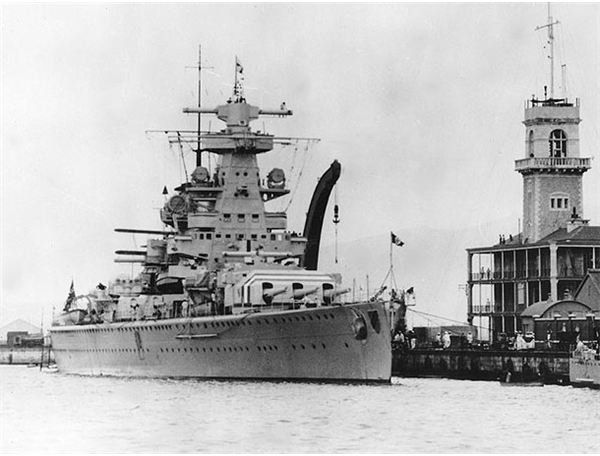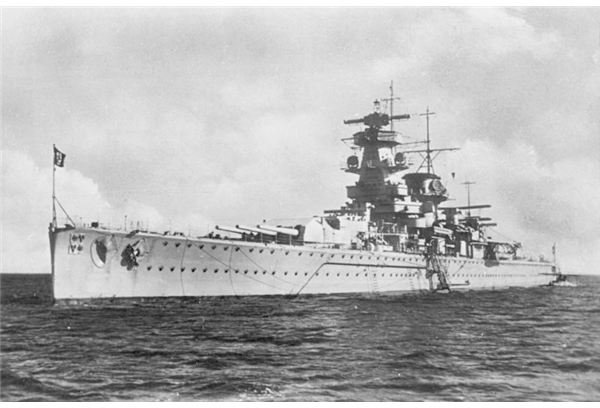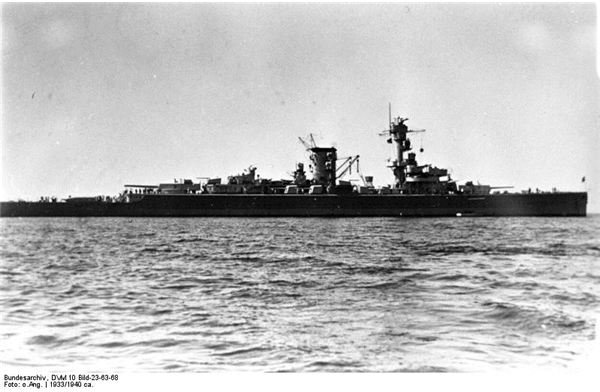The German Pocket Battleships in World War Two
The Deutschland Class: Pushing the Treaty of Versailles to the Limit
After World War 1 concluded, the Treaty of Versailles denied Germany the right to build any warship that had a displacement of more than 10,000 tons - effectively restricting Germany from building warships more powerful than the heavy cruisers of the time. This was a stipulation of the treaty because of major British concerns about the growth potential of any German navy, which had been building in the pre-war years into a force that could conceivable challenge the Royal Navy’s dominance of the high seas.
So in the Weimar period between the end of World War 1 and Hitler’s seizure of power in 1933, Germany could not build any capital ships. Still, the remaining German naval leadership wanted to create a naval force that could help defend German interests abroad and keep Germany’s North Sea and Baltic coasts secure from attack. As a result they set about designing the largest ships they could while still technically adhering to the 10,000 ton provision of the Versailles Treaty.
The resulting design became known in the English speaking world as the pocket battleship. Although the German Navy called the vessels Panzerschiffe, or “armored cruiser”, their main armament of six 11" guns and long range made them something much more than a heavy cruiser, and yet not sufficiently powerful to be considered a battle cruiser.
The Pocket Battleship: Definition of Function over Form
The advent of National Socialist control of the government in 1933 had the effect of expanding the size of the vessels so that they clearly defied the Versailles Treaty, but not so much as to provoke a military response. Their displacement ballooned to up to 12,000 tons, and at their launches in the early 1930’s they were the primary ships of the line for the new Kriegsmarine - at least until the Scharnhorst class battlecruisers and Bismarck class battleships could come online.
They were, and remain, unique vessels even at first glance. A vast amount of fuel, engine horsepower, and gunnery was packed into a hull that was as long as some older battleships yet as light as many contemporary cruisers. The Deutschland class pocket battleships even looked more like battleships than cruisers, sporting large triple barrel turrets and a disproportionately tall superstructure relative to their size. Of course, these quirks design were meant to create tactical advantages in combat, not to adhere to any aesthetic of naval vessel design. The three sisters that comprised the class - Graf Spee, Admiral Scheer, and Deutschland (whose name was later changed to Lutzow) were meant to carry heavy guns far into the Atlantic where they could be used to break apart convoys bound for Britain.
The Deutschland Class in World War Two
The pocket battleships played an important role in the Second World War at sea - perhaps a disproportionately large role relative to their power and the cost of building and maintaining them. Soon after the outbreak of the conflict in 1939, the Lutzow and Graf Spee were dispatched to the Atlantic to begin hunting the merchant vessels carrying vital supplies to sustain Britain during the war, and after surviving a British air attack that cost the RAF four bombers and did minimal damage, the Scheer went through an overhaul to optimize her for combat in the Atlantic.
The Lutzow destroyed two merchant ships before being reassigned to patrol the Baltic Sea, but the Graf Spee raided into the South Atlantic until December of 1939, sinking or capturing nine ships and tying up a disproportionately large portion of the Royal Navy which desperately tried to find and sink her. She was caught at sea by one heavy and two light cruisers operating in the South Atlantic, and though she inflicted major damage on the heavy cruiser, she was blockaded in a neutral port in South America and scuttled to avoid capture.

The most successful of the three vessels was the Admiral Scheer, which sank nearly twenty merchant ships and escorts - seven out of a single convoy in 1940. She afterwards operated north out of Norway harassing convoys bound for Soviet Russia, and later even provided gunnery support for retreating German forces near the Baltic Coast.
The Fate of the Deutschland Class Pocket Battleships
The Graf Spee was scuttled after the Battle of the River Plate, for although she performed well and badly damaged a British heavy cruiser, when she put into the neutral port of Montevideo for repairs her captain, Langsdorff, believed that he would be overwhelmed by superior forces upon leaving harbor. In order to save the lives of his crewmen, he ordered the Graf Spee scuttled in the harbor.

Concerning the conduct of the Graf Spee during its months at sea while raiding British merchant shipping: no merchant sailor was killed on any of the nine ships that fell victim to the Graf Spee, and of those kept prisoner on the pocket battleship herself all reported that they were treated well by Captain Langsdorff and his crew. Only a single instance of human kindness amidst all the horror of that war, but one that should not be forgotten.
Admiral Scheer made it through the majority of the war intact, and operated from the Barents Sea north of the Soviet Union all the way into the Indian Ocean, ravaging British shipping along the way. One of the most successful of the surface raiders to put to sea, the Scheer ended the war in the Baltic, providing fire support to the embattled German troops surrounded in the Courland pocket and later participating as a repatriation ship evacuating German soldiers and civilians from East Prussia. In April 1945 a raid of hundreds of Allied bombers destroyed the vessel in port.
The Deutschland, renamed Lutzow, spent most of the war in the Baltic, and was scuttled in port before the advancing Soviet Army could capture her intact. Later raised by the Soviets and added to the Baltic Fleet, she was eventually scuttled in 1947
Technical Specifications and Sources
Deutschland Class Pocket Battleship - Definition of class status by German sources originally Panzerschiffe (Armored Cruiser) and later simply Heavy Cruiser.
- 610 ft long, 71 ft beam, 24 ft draught, up to 12,000 tons displacement
- 8 diesel engines providing over 52,000 hp
- 28.5 knot top speed, approximately 9000 nautical miles range at 20 knots
- Main armament six 11" (283mm) naval guns in two triple turrets
- Secondary armament eight 5.9 inch (150mm) and six 105mm guns
- Eight 37mm and ten 20mm anti-aircraft guns, eight torpedo tubes
- One or two seaplanes for reconnaissance
- The armor of the vessels was proven, by the Graf Spee at the Battle of the River Plate, to be capable of withstanding multiple six inch (150mm-155mm) shell impacts. However, eight inch (200mm-205mm) shells were able to penetrate Graf Spee’s armor, causing critical damage to the vessel’s vital water purification system.
Sources:
Janes Fighting Ships of World War II, 1946 Janes Publishing Company, 1994 reprint edition
John Asmussen, Deutschland/Lützow & Admiral Scheer & Admiral Graf Spee
Images are courtesy of the Deutsches Bundesarchiv (German Federal Archive) and the United States Naval Historical Center. Accessed via Wiki Commons
